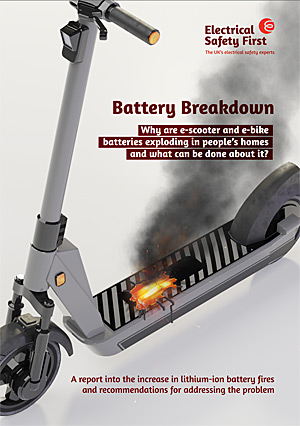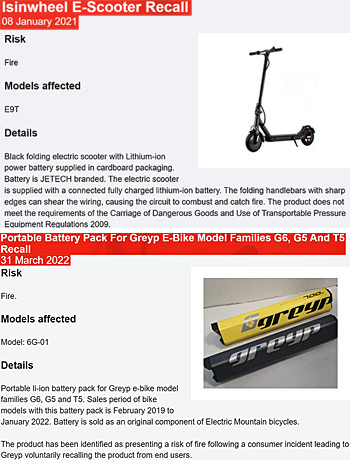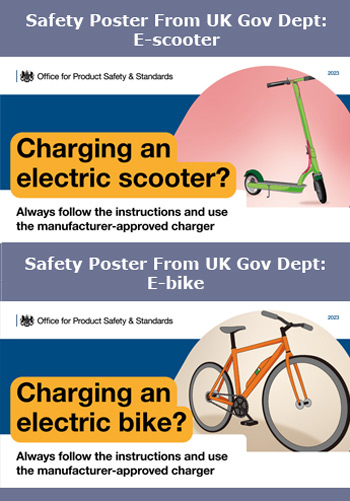The spate of fires related to e-bike and e-scooter charging in the UK is on the increase according to media and Fire Rescue Services reports. With a new major report having been issued (available from this websites E-Library) by Electrical Safety First (ESF) the fire safety of the products is becoming complicated due to the supplying of counterfeit product increasing in the country, and in the case of faulty manufacturer or of the batteries.
 The risk is due to the power source used on these E-bike and E-scooter vehicles, which are becoming increasingly popular.
The risk is due to the power source used on these E-bike and E-scooter vehicles, which are becoming increasingly popular.
Most are powered by lithium-ion batteries which can be charged in the home. It is important to charge e-bikes and e-scooters safely to avoid a risk of a fire starting and putting your families and homes at risk, as well as the safe storage and disposal of the batteries.
Charging lithium-ion batteries at home can pose certain risks, and it's crucial for owners to take necessary precautions to prevent such incidents.
But why is this happening to E-scooters and E-bikes which are being sold as a consumer article, which buyers assume are completely safe?
Many fires involve counterfeit electrical goods. Items which don’t meet British or European standards pose a huge fire risk and while genuine chargers (or battery packs) may cost more, it’s not worth putting the risk by buying a fake charger to save a few pounds.
Here are some potential reasons why e-scooters/e-bikes might explode or catch fire:
- Battery issues: E-scooters/bikes are powered by lithium-ion batteries, and if these batteries are defective, damaged, or poorly manufactured, they can experience thermal runaway. This can lead to a rapid increase in temperature, causing the battery to explode or catch fire.
- Overcharging: Charging an e-scooter/bike beyond its recommended charging time or using a charger with higher voltage output than specified by the manufacturer can cause the battery to overheat and become unstable.
- Incompatible chargers: Using chargers not specifically designed for the e-scooter/bike or using counterfeit
chargers can lead to voltage mismatches and result in battery damage and possible fire hazards.
- Physical damage: Accidents or impacts that damage the battery or internal components of the e-scooter/bike can create short circuits, increasing the risk of fires.
- Poor quality or counterfeit e-scooters/bikes: Low-quality or counterfeit e-scooters may not adhere to proper safety standards and may use substandard batteries, increasing the risk of explosions or fires.
Given the potential dangers, it's essential for e-bike and e-scooter owners to follow safety guidelines provided by manufacturers and local authorities.
 The best way of ensuring you are up-to-date with manufacturer’s guidelines, is to register your product with the manufacturer to validate any warranties – batteries are usually included in warranties. Registering makes it easier for manufacturers to contact you in the event of safety or recall information.
The best way of ensuring you are up-to-date with manufacturer’s guidelines, is to register your product with the manufacturer to validate any warranties – batteries are usually included in warranties. Registering makes it easier for manufacturers to contact you in the event of safety or recall information.
Check any products you have bought are not subject to a product recall, and if the manufacturer of your E-scooter/E-bike does not [provide such information; you can also do this by checking Electrical Safety First’s website which details electrical products subjected to recalls.
An example of an E-scooter recall is shown in the images to the right below and taken from the ESF website.
The KEY safety measures that can help reduce the risk of fires are:
- Purchase from reputable brands: Buy e-scooters/bikes from well-known and trusted manufacturers with a good track record for safety.
- Read the user manual: Familiarize yourself with the manufacturer's guidelines for charging, maintaining, and using your E-scooter/Bike, and follow them diligently.
- Follow manufacturer guidelines: Always follow the manufacturer's instructions for charging and maintaining your E-scooter or E-bike.
- Use manufacturer-approved chargers: Only use chargers that are specifically designed for your e-bike or e-scooter model and provided by the manufacturer. Using unauthorized or counterfeit chargers can lead to voltage mismatches and battery malfunctions.
- Do not overload socket outlets or use inappropriate extension leads.
- Charge batteries whilst you are awake and alert so if a fire should occur you can respond quickly. Don’t leave batteries to charge while you are asleep or away from the home.
- If you do need to charge at home overnight - make sure ALL internal doors are firmly closed.
- Avoid overcharging: Charge your e-bike or e-scooter only when necessary and unplug it as soon as it reaches a full charge. Avoid leaving it charging unattended for extended periods, especially overnight.
- Charging location: Place your e-bike or e-scooter on a stable and non-flammable surface while charging. Avoid charging near flammable materials or in confined spaces without proper ventilation.
- If possible, charge electric bike or scooter batteries somewhere outside of your home, e.g. external garage which has appropriate ventilation.
- Inspect for damage: Regularly inspect the charging cables, connectors, and the vehicle itself for any signs of damage, wear, or malfunction. Replace damaged parts or batteries immediately.
- Store safely: When not in use or charging, store your e-bike or e-scooter in a cool and dry location, away from direct sunlight and heat sources.
- Avoid extreme conditions: Do not expose your e-scooter to extreme temperatures, such as leaving it in a hot car during summer.
- In the event of an e-bike, e-scooter or lithium-ion battery fire – do not attempt to extinguish the fire. Get out, stay out, call 999
 Additionally, raising awareness among e-bike and e-scooter owners about the potential risks and safety measures through public campaigns, social media, and community events can also be beneficial in preventing such incidents.
Additionally, raising awareness among e-bike and e-scooter owners about the potential risks and safety measures through public campaigns, social media, and community events can also be beneficial in preventing such incidents.
If you experience any issues with your e-scooter, such as unusual smells, smoke, or overheating, stop using it immediately and seek assistance from the manufacturer or a qualified technician. Safety should always be a top priority when using any electrical or battery-powered device.
E-scooter and E-bike injuries and deaths can occur due to various reasons, including:
- Accidents: E-scooter/E-bike riders can be involved in accidents with other vehicles, pedestrians, or stationary objects, leading to serious injuries and fatalities.
- Collisions with pedestrians: In some cases, e-scooter/e-bike riders may collide with pedestrians, resulting in severe injuries or fatalities for both parties.
- Rider behaviour: Unsafe riding practices, such as reckless speeding or riding under the influence of alcohol or drugs, can increase the risk of accidents and fatalities.
- Incorrect use of E-scooters in particular. All too often the use of an E-scooter which is made for the use of just one person, has two passengers using the one scooter.
- Infrastructure issues: Uneven road surfaces, potholes, and other infrastructure problems can lead to accidents, especially if the rider is not attentive, or there are two people on the one E-scooter or E-bike.
For information on the legal aspects of using E-scooter and E-bikes go to the Government Website providing information and guidance, including recent Court rulings: here
And finally, but not least:
The issue of damage and safe disposal:
- Batteries can be damaged by dropping them or crashing e-bikes or e-scooters
- Where the battery is damaged, it can overheat and catch fire without warning. Check your battery regularly for any signs of damage and if you suspect it is damaged it should be replaced and should not be used or charged
- If you need to dispose of a damaged or end of life battery, don’t dispose of it in your household waste or normal
recycling. These batteries, when punctured or crushed can cause fires in bin lorries, recycling and waste centres. Your e-bike or e-scooter manufacturer may offer a recycling service.
Remember, prevention is key, and taking proper precautions can significantly reduce the risk of E-scooter and E-bike fires at home.
Source: Wirral Globe / Merseyside Fire & Rescue Service / ESF / Unionsafety / Gov.UK




